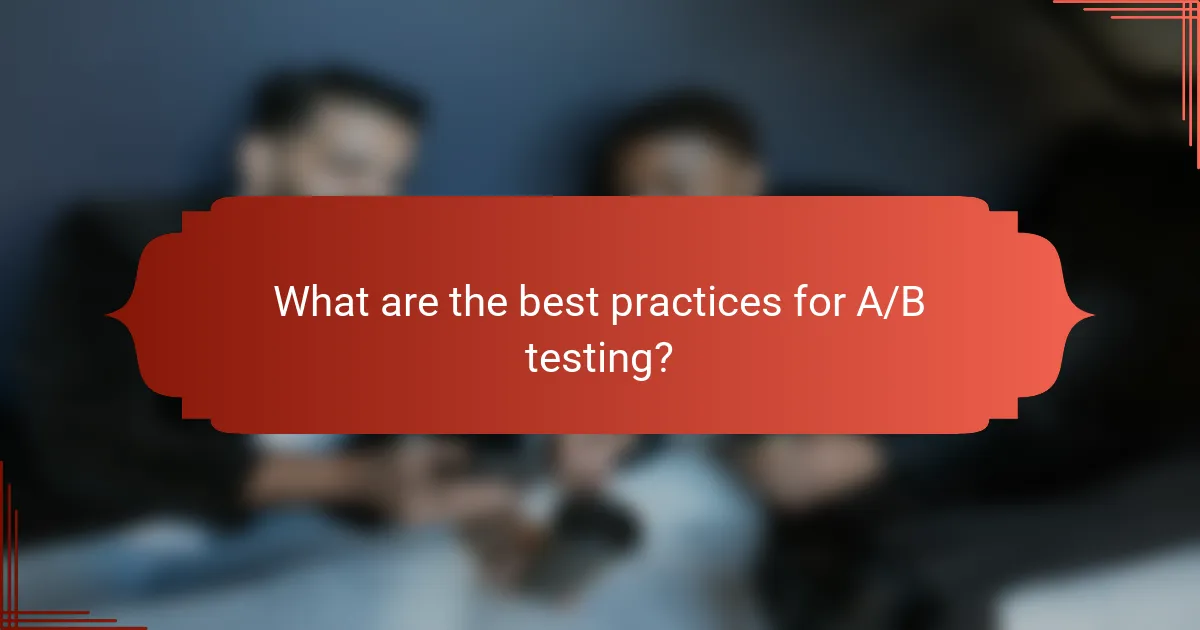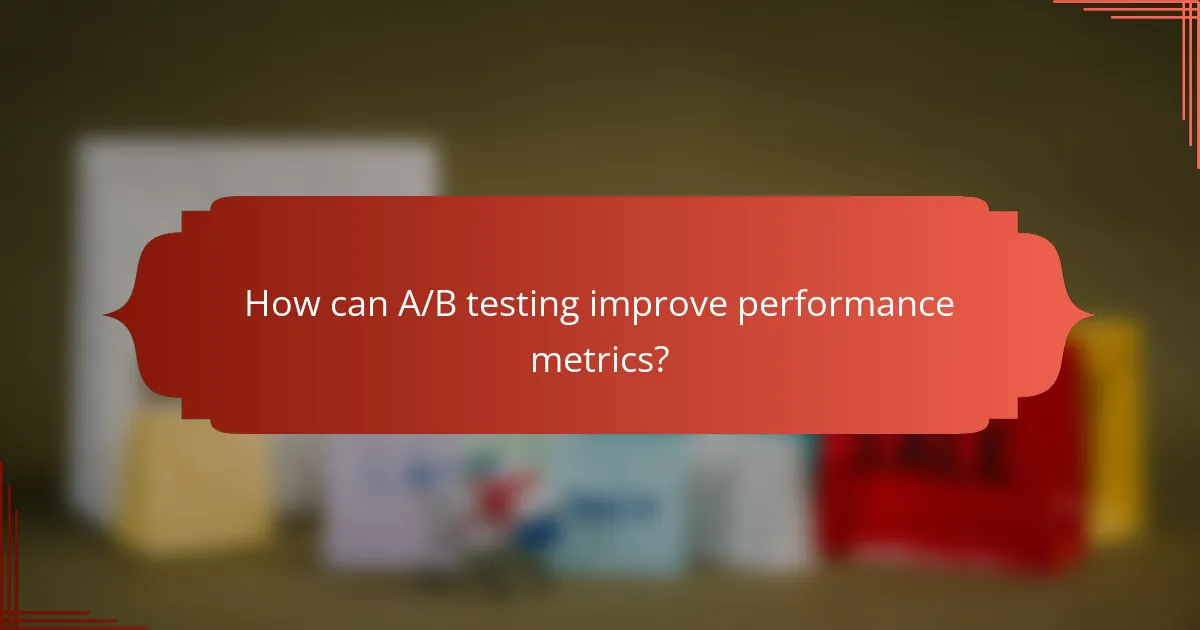A/B testing is a powerful strategy for businesses looking to optimize their marketing efforts and improve user experience. By comparing different versions of web pages or applications, companies can gain valuable insights that lead to significant performance gains. Utilizing effective A/B testing tools tailored to specific needs is essential for streamlining this process and achieving better outcomes.

What are the best A/B testing strategies for UK businesses?
The best A/B testing strategies for UK businesses focus on data-driven insights, user experience, and targeted testing methods. Implementing these strategies can lead to significant performance gains by optimizing marketing efforts and enhancing customer satisfaction.
Data-driven decision making
Data-driven decision making involves using quantitative data to guide A/B testing strategies. By analyzing user behavior and engagement metrics, businesses can identify which variations are most effective. This approach minimizes guesswork and maximizes the potential for improved conversion rates.
Utilize analytics tools to gather data on user interactions, such as click-through rates and bounce rates. Regularly review this data to inform your testing hypotheses and refine your strategies over time.
User experience optimization
User experience optimization is crucial for successful A/B testing. Enhancing the user journey can lead to higher satisfaction and increased conversions. Focus on elements like page load speed, navigation simplicity, and content relevance.
For example, test different layouts or call-to-action buttons to see which design resonates best with your audience. A well-optimized user experience can significantly impact retention and loyalty.
Segmented testing
Segmented testing allows businesses to tailor A/B tests to specific audience segments. By analyzing different demographics, behaviors, or preferences, you can create more personalized experiences that resonate with each group.
Consider segmenting your audience by age, location, or purchasing behavior. This targeted approach can reveal insights that broad tests may overlook, leading to more effective marketing strategies.
Multivariate testing
Multivariate testing involves testing multiple variables simultaneously to understand their combined effect on user behavior. This method is more complex than A/B testing but can yield deeper insights into how different elements interact.
For instance, you might test various headlines, images, and button colors at the same time. While this approach can provide comprehensive data, ensure you have sufficient traffic to achieve statistically significant results.

Which tools are most effective for A/B testing?
Effective A/B testing tools streamline the process of comparing different versions of web pages or applications to determine which performs better. Key tools vary in features, ease of use, and integration capabilities, making it essential to choose one that aligns with your specific needs.
Optimizely
Optimizely is a leading A/B testing platform known for its user-friendly interface and robust features. It allows users to create experiments without extensive coding knowledge, making it accessible for marketers and product managers alike.
With Optimizely, you can run experiments on web pages, mobile apps, and even server-side applications. Consider its pricing model, which can be on the higher side, but it offers extensive support and analytics capabilities.
VWO
VWO (Visual Website Optimizer) is another popular choice that combines A/B testing with additional features like heatmaps and user recordings. This tool provides a comprehensive view of user behavior, helping you understand why certain variations perform better.
VWO is particularly useful for small to medium-sized businesses due to its competitive pricing and ease of use. It offers a free trial, allowing you to test its features before committing to a subscription.
Google Optimize
Google Optimize is a free tool that integrates seamlessly with Google Analytics, making it a great option for those already using Google’s ecosystem. It allows for easy setup of A/B tests and multivariate testing with a straightforward interface.
While it lacks some advanced features found in paid tools, Google Optimize is an excellent starting point for businesses looking to experiment without significant investment. It’s ideal for small projects or initial testing phases.
Adobe Target
Adobe Target is part of the Adobe Experience Cloud and offers powerful A/B testing capabilities along with personalization features. It is designed for larger enterprises that require advanced targeting and segmentation options.
While Adobe Target can be complex and may require a steeper learning curve, its integration with other Adobe tools can provide significant advantages for comprehensive marketing strategies. Businesses should weigh the investment against the potential for enhanced customer experiences.

How can A/B testing improve performance metrics?
A/B testing enhances performance metrics by allowing businesses to compare two versions of a webpage or app feature to determine which one performs better. This data-driven approach helps optimize user experience and drive key outcomes like conversions and engagement.
Increased conversion rates
One of the primary benefits of A/B testing is its ability to significantly increase conversion rates. By testing variations of landing pages, calls to action, or product descriptions, businesses can identify which elements resonate most with users. For instance, a simple change in button color or text can lead to conversion improvements of several percentage points.
To maximize conversion gains, focus on high-traffic pages and prioritize tests that align with your business goals. Regularly analyze results and iterate based on user feedback to continuously enhance conversions.
Enhanced user engagement
A/B testing can lead to enhanced user engagement by identifying content and features that capture attention. Testing different headlines, images, or layouts can reveal what keeps users on the page longer and encourages interaction. For example, a more engaging video thumbnail may increase click-through rates significantly.
To foster engagement, consider segmenting your audience and tailoring tests to specific user groups. This targeted approach can yield insights into preferences and behaviors, allowing for more personalized experiences that drive deeper engagement.
Lower bounce rates
Lowering bounce rates is another critical advantage of A/B testing, as it helps retain visitors on your site. By experimenting with different page designs or content placements, you can discover which variations encourage users to explore further rather than leaving immediately. For example, adding relevant links or improving load times can effectively reduce bounce rates.
To achieve lower bounce rates, prioritize testing elements that impact first impressions, such as page speed and initial content visibility. Regularly monitor analytics to identify pages with high bounce rates and target them for A/B testing to enhance overall site performance.

What are the prerequisites for successful A/B testing?
Successful A/B testing requires clear objectives, a robust sample size, and defined metrics. These elements ensure that the tests yield reliable and actionable insights, ultimately leading to informed decision-making.
Clear objectives
Establishing clear objectives is crucial for A/B testing. These objectives should define what you aim to achieve, such as increasing conversion rates, improving user engagement, or enhancing customer satisfaction. Without specific goals, it becomes challenging to measure the success of your tests.
For instance, if your objective is to boost sales, you might focus on testing different product page layouts to see which one leads to higher purchase rates. Clearly articulated goals guide the entire testing process and help prioritize which variations to test.
Robust sample size
A robust sample size is essential to ensure that your A/B test results are statistically significant. A small sample may lead to misleading conclusions due to random variations. Generally, aim for a sample size that allows you to detect meaningful differences between variations with a high degree of confidence.
As a rule of thumb, consider using a sample size calculator to determine the number of participants needed based on your expected conversion rates and the minimum effect size you wish to detect. Testing with at least a few hundred participants per variation is often a good starting point.
Defined metrics
Defining metrics is vital for evaluating the performance of your A/B tests. Choose metrics that align with your objectives, such as conversion rates, click-through rates, or average order value. These metrics will provide a clear picture of how each variation performs against your goals.
Be cautious not to focus on too many metrics at once, as this can complicate analysis. Instead, prioritize a few key performance indicators (KPIs) that directly relate to your objectives. Regularly review these metrics to assess the effectiveness of your tests and make data-driven decisions moving forward.

How to choose the right A/B testing tool for your needs?
Selecting the right A/B testing tool depends on your specific requirements, such as budget, ease of use, and desired features. Consider tools that align with your testing goals and provide robust analytics to measure performance effectively.
Key features to look for
When evaluating A/B testing tools, prioritize features like user-friendly interfaces, integration capabilities with your existing systems, and comprehensive reporting options. Look for tools that offer multivariate testing, segmentation, and real-time data analysis to enhance your testing process.
Additionally, consider whether the tool supports mobile and web testing, as well as its ability to handle various traffic volumes. Some tools may also provide built-in statistical significance calculators to help you interpret results accurately.
Popular A/B testing tools
Several A/B testing tools are widely recognized for their effectiveness. Google Optimize is a free option that integrates seamlessly with Google Analytics, making it a great choice for beginners. Optimizely and VWO offer more advanced features and are suitable for larger businesses with complex testing needs.
Other notable tools include Unbounce, which focuses on landing page optimization, and Convert, known for its robust customer support. Evaluate these tools based on your budget, as prices can range from free to several hundred dollars per month.
Budget considerations
Budget is a crucial factor when choosing an A/B testing tool. Free tools like Google Optimize can be sufficient for small businesses or startups, while premium options may offer more advanced features that justify their costs. Expect to pay anywhere from $50 to $500 per month for more comprehensive solutions.
Consider the potential return on investment (ROI) from improved conversion rates when assessing your budget. Investing in a high-quality tool can lead to significant performance gains, making it worthwhile in the long run.
Common pitfalls to avoid
One common pitfall is not defining clear objectives before starting your A/B tests. Ensure you have specific goals, such as increasing click-through rates or reducing bounce rates, to guide your testing process. Additionally, avoid running multiple tests simultaneously, as this can complicate results and lead to inaccurate conclusions.
Another mistake is neglecting to analyze results thoroughly. Always check for statistical significance to ensure your findings are reliable. Lastly, don’t forget to consider user experience; changes should enhance usability, not detract from it.